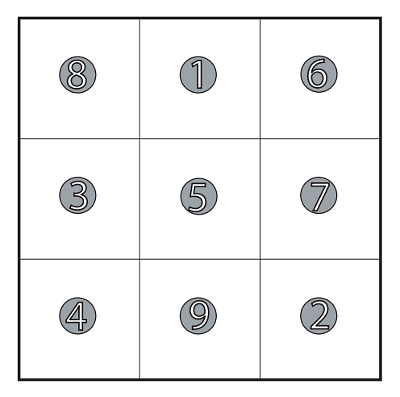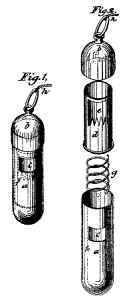
An engraving by Johann Martin Will, 1780.
Andrew Wyeth said, “I prefer winter and fall, when you feel the bone structure of the landscape. Something waits beneath it; the whole story doesn’t show.”

An engraving by Johann Martin Will, 1780.
Andrew Wyeth said, “I prefer winter and fall, when you feel the bone structure of the landscape. Something waits beneath it; the whole story doesn’t show.”
A devilish puzzle by Lee Sallows:

In the diagram above, nine numbered counters occupy the cells of a 3×3 checkerboard so as to form a magic square. Any 3 counters lying in a straight line add up to 15. There are 8 of these collinear triads.
Reposition the counters (again, one to each cell) to yield 8 new collinear triads, but now showing a common sum of 16 rather than 15.
“Every man’s work, whether it be literature, or music, or pictures, or architecture, or anything else, is always a portrait of himself.” — Samuel Butler

A trap for gullible tapeworms, patented in 1854 by Alpheus Myers.
The capsule is baited and swallowed by the patient, after a fast “to make the worm hungry.” The worm seizes the bait, the trap closes on its head, and the doctor withdraws the whole length of the parasite from the patient’s stomach, presumably with a magician’s flourish.
“In constructing the trap, care should be taken that the spring g, is only strong enough to hold the worm, and not strong enough to cause his head to be cut off.”
scoteography
n. the art of writing in the dark
This problem dates from at least 1774; this version appeared in the American Mathematical Monthly of December 1902:
Three Dutchmen and their wives went to market to buy hogs. The names of the men were Hans, Klaus, and Hendricks, and of the women, Gertrude, Anna, and Katrine; but it was not known which was the wife of each man. They each bought as many hogs as each man or woman paid shillings for each hog, and each man spent three guineas more than his wife. Hendricks bought 23 hogs more than Gertrude, and Klaus bought 11 more than Katrine. What was the name of each man’s wife?
(There are 21 shillings in a guinea.)
An English professor was training her students in memorization techniques.
“For instance,” she said, “if you want to remember the name of a certain poet, Bobbie Burns, you could visualize a London policeman in flames.” She drew a picture in chalk. “You see? ‘Bobbie Burns.'”
A student raised his hand and asked, “How could we know that’s not ‘Robert Browning’?”

In 1969, convinced that anything prurient would sell in the era of Harold Robbins and Jacqueline Susann, Newsday columnist Mike McGrady decided to manufacture his own bestseller. He asked 24 colleagues to write a chapter apiece, following two rules: They had to write badly, and there had to be an “unremitting emphasis on sex”:
In the darkened room, now thirstier than ever, Gillian was suddenly aware of the presence beside her of Mario Vella. He had allowed his left elbow to brush gently against her. In any other surrounding, in any other circumstances, Gillian Blake would have gracefully withdrawn. She didn’t. She held her ground and his elbow became more persistent.
Sadly, McGrady was right. With two sex scenes per chapter, Naked Came the Stranger quickly became a national bestseller, ending the year at number 7 on the fiction charts, five slots behind The Godfather.
“Penelope Ashe’s scorching novel makes Portnoy’s Complaint and Valley of the Dolls read like Rebecca of Sunnybrook Farm,” wrote the Long Island Press. And the Asheville, N.C., Citizen-Times said it was “witty and written in good taste, and brings out many new angles in man-woman relationships.”
“These are the kind of people,” McGrady told Life, “who are running around setting literary standards.”
The vice president of a company went to the chairman of the board and said, ‘We are thinking of starting a new program. It will help us increase profits, but it will also harm the environment.’ The chairman of the board answered, ‘I don’t care at all about harming the environment. I just want to make as much profit as I can. Let’s start the new program.’ They started the new program. Sure enough, the environment was harmed.
Did the chairman harm the environment intentionally? In a 2003 study, 82 percent of respondents said yes, he did. But now consider this:
The vice president of a company went to the chairman of the board and said, ‘We are thinking of starting a new program. It will help us increase profits, and it will also help the environment.’ The chairman of the board answered, ‘I don’t care at all about helping the environment. I just want to make as much profit as I can. Let’s start the new program.’ They started the new program. Sure enough, the environment was helped.
Did the chairman help the environment intentionally? Only 23 percent of respondents said yes.
What should we make of this? Yale philosopher Joshua Knobe says, “It seems very puzzling that all we changed was this one word, just changing the word harm to help, and yet we’re now having completely different judgments about whether what he did was intentional or unintentional. Yet it seems like it’s only the moral status of what he did that is changing. … Somehow the moral judgments people are making are affecting their intuitions about something like how the mind works.”
Once — but no matter when —
There lived — no matter where —
A man whose name — but then
I need not that declare.
He — well, he had been born,
And so he was alive;
His age — I details scorn —
Was somethingty and five.
He lived — how many years
I truly can’t decide;
But this one fact appears
He lived — until he died.
“He died,” I have averred,
But cannot prove ’twas so,
But that he was interred,
At any rate, I know.
I fancy he’d a son,
I hear he had a wife:
Perhaps he’d more than one,
I know not, on my life!
But whether he was rich,
Or whether he was poor,
Or neither — both — or which,
I cannot say, I’m sure.
I can’t recall his name,
Or what he used to do:
But then — well, such is fame!
‘Twill so serve me and you.
And that is why I thus,
About this unknown man
Would fain create a fuss,
To rescue, if I can,
From dark oblivion’s blow,
Some record of his lot:
But, ah! I do not know
Who — where — when — why — or what.
MORAL
In this brief pedigree
A moral we should find —
But what it ought to be
Has quite escaped my mind!
— William T. Dobson, Literary Frivolities, Fancies, Follies and Frolics, 1880